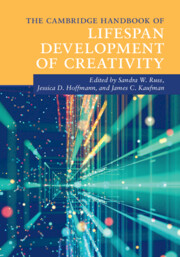26 results
14 - Affect in Pretend Play and Creativity
- from Part III - Emotions and the Creative Person
-
-
- Book:
- The Cambridge Handbook of Creativity and Emotions
- Published online:
- 16 February 2023
- Print publication:
- 23 February 2023, pp 262-279
-
- Chapter
- Export citation
Part II - The Development of Creativity
-
- Book:
- The Cambridge Handbook of Lifespan Development of Creativity
- Published online:
- 19 November 2021
- Print publication:
- 25 November 2021, pp 99-262
-
- Chapter
- Export citation
Acknowledgments
-
- Book:
- The Cambridge Handbook of Lifespan Development of Creativity
- Published online:
- 19 November 2021
- Print publication:
- 25 November 2021, pp xiv-xiv
-
- Chapter
- Export citation
Figures
-
- Book:
- The Cambridge Handbook of Lifespan Development of Creativity
- Published online:
- 19 November 2021
- Print publication:
- 25 November 2021, pp x-x
-
- Chapter
- Export citation
Epilogue: What Have We Learned?
- from Part V - Special Populations
-
-
- Book:
- The Cambridge Handbook of Lifespan Development of Creativity
- Published online:
- 19 November 2021
- Print publication:
- 25 November 2021, pp 552-558
-
- Chapter
- Export citation
Part III - Modes of Enhancement
-
- Book:
- The Cambridge Handbook of Lifespan Development of Creativity
- Published online:
- 19 November 2021
- Print publication:
- 25 November 2021, pp 263-392
-
- Chapter
- Export citation
Tables
-
- Book:
- The Cambridge Handbook of Lifespan Development of Creativity
- Published online:
- 19 November 2021
- Print publication:
- 25 November 2021, pp xi-xi
-
- Chapter
- Export citation
Part I - Core Concepts of Lifespan Creativity Development
-
- Book:
- The Cambridge Handbook of Lifespan Development of Creativity
- Published online:
- 19 November 2021
- Print publication:
- 25 November 2021, pp 3-98
-
- Chapter
- Export citation
6 - Development of Creativity in School-Age Children
- from Part II - The Development of Creativity
-
-
- Book:
- The Cambridge Handbook of Lifespan Development of Creativity
- Published online:
- 19 November 2021
- Print publication:
- 25 November 2021, pp 126-138
-
- Chapter
- Export citation
Introduction
-
-
- Book:
- The Cambridge Handbook of Lifespan Development of Creativity
- Published online:
- 19 November 2021
- Print publication:
- 25 November 2021, pp 1-2
-
- Chapter
- Export citation
Copyright page
-
- Book:
- The Cambridge Handbook of Lifespan Development of Creativity
- Published online:
- 19 November 2021
- Print publication:
- 25 November 2021, pp iv-iv
-
- Chapter
- Export citation
Part IV - Environments and Contexts
-
- Book:
- The Cambridge Handbook of Lifespan Development of Creativity
- Published online:
- 19 November 2021
- Print publication:
- 25 November 2021, pp 393-494
-
- Chapter
- Export citation
Part V - Special Populations
-
- Book:
- The Cambridge Handbook of Lifespan Development of Creativity
- Published online:
- 19 November 2021
- Print publication:
- 25 November 2021, pp 495-558
-
- Chapter
- Export citation
Dedication
-
- Book:
- The Cambridge Handbook of Lifespan Development of Creativity
- Published online:
- 19 November 2021
- Print publication:
- 25 November 2021, pp v-vi
-
- Chapter
- Export citation
Contents
-
- Book:
- The Cambridge Handbook of Lifespan Development of Creativity
- Published online:
- 19 November 2021
- Print publication:
- 25 November 2021, pp vii-ix
-
- Chapter
- Export citation
3 - Pretend Play
- from Part I - Core Concepts of Lifespan Creativity Development
-
-
- Book:
- The Cambridge Handbook of Lifespan Development of Creativity
- Published online:
- 19 November 2021
- Print publication:
- 25 November 2021, pp 40-55
-
- Chapter
- Export citation
Index
-
- Book:
- The Cambridge Handbook of Lifespan Development of Creativity
- Published online:
- 19 November 2021
- Print publication:
- 25 November 2021, pp 559-576
-
- Chapter
- Export citation
Contributors
-
- Book:
- The Cambridge Handbook of Lifespan Development of Creativity
- Published online:
- 19 November 2021
- Print publication:
- 25 November 2021, pp xii-xiii
-
- Chapter
- Export citation

The Cambridge Handbook of Lifespan Development of Creativity
-
- Published online:
- 19 November 2021
- Print publication:
- 25 November 2021
28 - Play and Creativity
- from Collaborative Creativity
-
-
- Book:
- The Cambridge Handbook of Creativity
- Published online:
- 12 April 2019
- Print publication:
- 25 April 2019, pp 607-622
-
- Chapter
- Export citation



